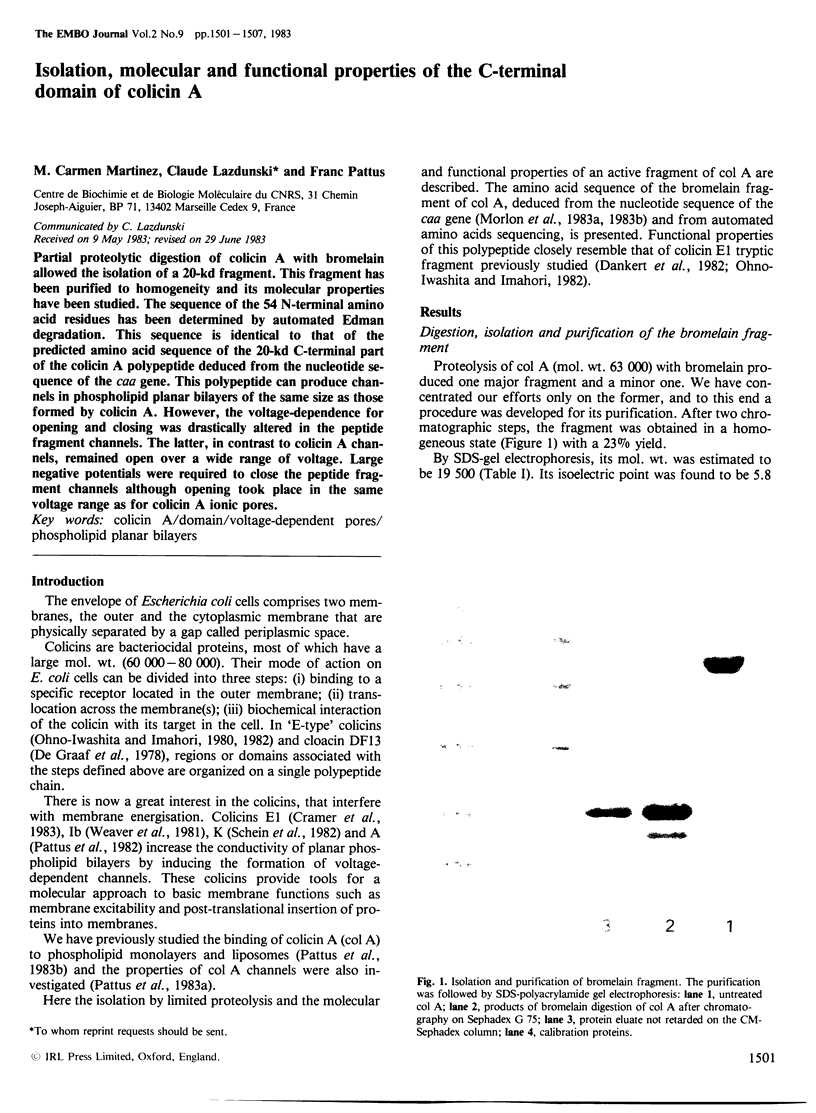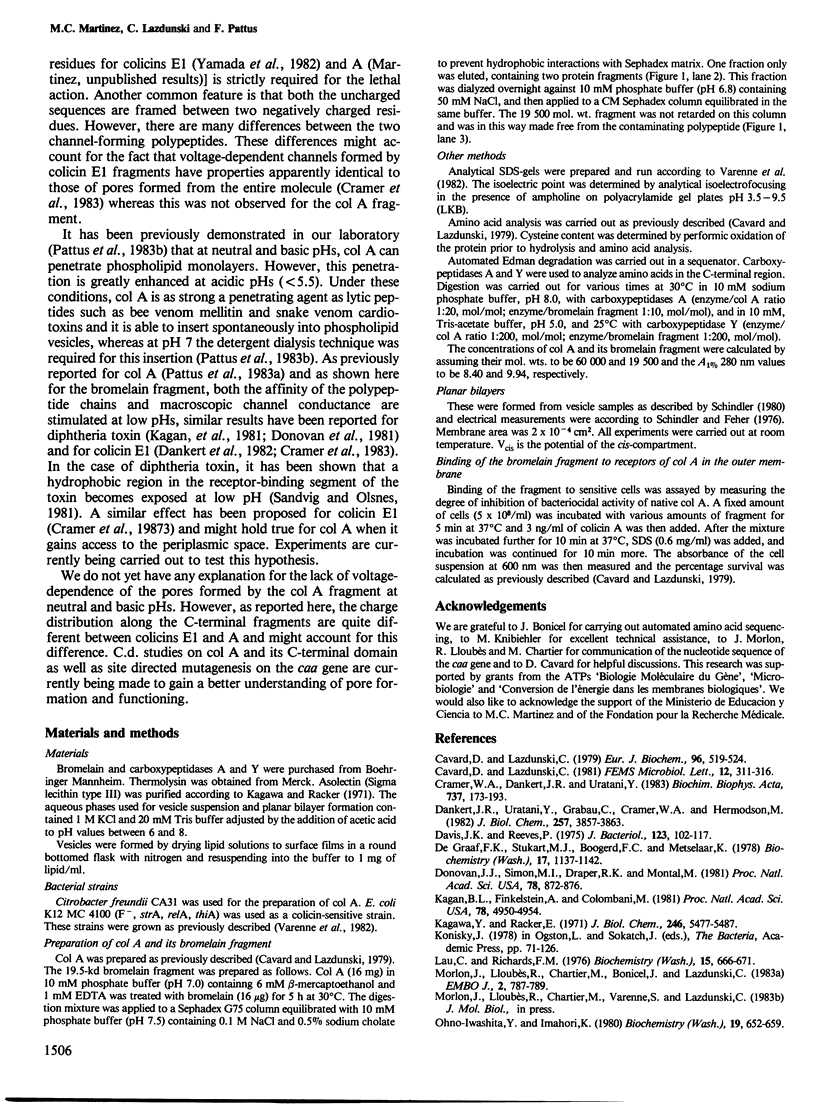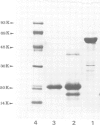Abstract
Partial proteolytic digestion of colicin A with bromelain allowed the isolation of a 20-kd fragment. This fragment has been purified to homogeneity and its molecular properties have been studied. The sequence of the 54 N-terminal amino acid residues has been determined by automated Edman degradation. This sequence is identical to that of the predicted amino acid sequence of the 20-kd C-terminal part of the colicin A polypeptide deduced from the nucleotide sequence of the caa gene. This polypeptide can produce channels in phospholipid planar bilayers of the same size as those formed by colicin A. However, the voltage-dependence for opening and closing was drastically altered in the peptide fragment channels. The latter, in contrast to colicin A channels, remained open over a wide range of voltage. Large negative potentials were required to close the peptide fragment channels although opening took place in the same voltage range as for colicin A ionic pores.
Full text
PDF






Images in this article
Selected References
These references are in PubMed. This may not be the complete list of references from this article.
- Cavard D., Lazdunski C. J. Purification and molecular properties of a new colicin. Eur J Biochem. 1979 Jun 1;96(3):519–524. doi: 10.1111/j.1432-1033.1979.tb13065.x. [DOI] [PubMed] [Google Scholar]
- Cramer W. A., Dankert J. R., Uratani Y. The membrane channel-forming bacteriocidal protein, colicin El. Biochim Biophys Acta. 1983 Mar 21;737(1):173–193. doi: 10.1016/0304-4157(83)90016-3. [DOI] [PubMed] [Google Scholar]
- Dankert J. R., Uratani Y., Grabau C., Cramer W. A., Hermodson M. On a domain structure of colicin E1. A COOH-terminal peptide fragment active in membrane depolarization. J Biol Chem. 1982 Apr 10;257(7):3857–3863. [PubMed] [Google Scholar]
- Davies J. K., Reeves P. Genetics of resistance to colicins in Escherichia coli K-12: cross-resistance among colicins of group A. J Bacteriol. 1975 Jul;123(1):102–117. doi: 10.1128/jb.123.1.102-117.1975. [DOI] [PMC free article] [PubMed] [Google Scholar]
- Kagan B. L., Finkelstein A., Colombini M. Diphtheria toxin fragment forms large pores in phospholipid bilayer membranes. Proc Natl Acad Sci U S A. 1981 Aug;78(8):4950–4954. doi: 10.1073/pnas.78.8.4950. [DOI] [PMC free article] [PubMed] [Google Scholar]
- Lau C., Richards F. M. Behavior of colicins E1, E2, and E3 attached to sephadex beads. Biochemistry. 1976 Feb 10;15(3):666–671. doi: 10.1021/bi00648a034. [DOI] [PubMed] [Google Scholar]
- Morlon J., Lloubes R., Chartier M., Bonicel J., Lazdunski C. Nucleotide sequence of promoter, operator and amino-terminal region of caa, the structural gene of colicin A. EMBO J. 1983;2(5):787–789. doi: 10.1002/j.1460-2075.1983.tb01501.x. [DOI] [PMC free article] [PubMed] [Google Scholar]
- Ohno-Iwashita Y., Imahori K. Assignment of the functional loci in colicin E2 and E3 molecules by the characterization of their proteolytic fragments. Biochemistry. 1980 Feb 19;19(4):652–659. doi: 10.1021/bi00545a008. [DOI] [PubMed] [Google Scholar]
- Ohno-Iwashita Y., Imahori K. Assignment of the functional loci in the colicin E1 molecule by characterization of its proteolytic fragments. J Biol Chem. 1982 Jun 10;257(11):6446–6451. [PubMed] [Google Scholar]
- Sandvig K., Olsnes S. Rapid entry of nicked diphtheria toxin into cells at low pH. Characterization of the entry process and effects of low pH on the toxin molecule. J Biol Chem. 1981 Sep 10;256(17):9068–9076. [PubMed] [Google Scholar]
- Schein S. J., Kagan B. L., Finkelstein A. Colicin K acts by forming voltage-dependent channels in phospholipid bilayer membranes. Nature. 1978 Nov 9;276(5684):159–163. doi: 10.1038/276159a0. [DOI] [PubMed] [Google Scholar]
- Schindler H., Feher G. Branched bimolecular lipid membranes. Biophys J. 1976 Sep;16(9):1109–1113. doi: 10.1016/S0006-3495(76)85759-1. [DOI] [PMC free article] [PubMed] [Google Scholar]
- Schindler H. Formation of planar bilayers from artificial or native membrane vesicles. FEBS Lett. 1980 Dec 15;122(1):77–79. doi: 10.1016/0014-5793(80)80405-4. [DOI] [PubMed] [Google Scholar]
- Varenne S., Knibiehler M., Cavard D., Morlon J., Lazdunski C. Variable rate of polypeptide chain elongation for colicins A, E2 and E3. J Mol Biol. 1982 Jul 25;159(1):57–70. doi: 10.1016/0022-2836(82)90031-6. [DOI] [PubMed] [Google Scholar]
- Weaver C. A., Kagan B. L., Finkelstein A., Konisky J. Mode of action of colicin ib: formation of ion-permeable membrane channels. Biochim Biophys Acta. 1981 Jul 6;645(1):137–142. doi: 10.1016/0005-2736(81)90521-6. [DOI] [PubMed] [Google Scholar]
- Yamada M., Ebina Y., Miyata T., Nakazawa T., Nakazawa A. Nucleotide sequence of the structural gene for colicin E1 and predicted structure of the protein. Proc Natl Acad Sci U S A. 1982 May;79(9):2827–2831. doi: 10.1073/pnas.79.9.2827. [DOI] [PMC free article] [PubMed] [Google Scholar]
- de Graaf F. K., Stukart M. J., Boogerd F. C., Metselaar K. Limited proteolysis of cloacin DF13 and characterization of the cleavage products. Biochemistry. 1978 Mar 21;17(6):1137–1142. doi: 10.1021/bi00599a031. [DOI] [PubMed] [Google Scholar]




